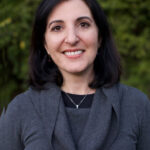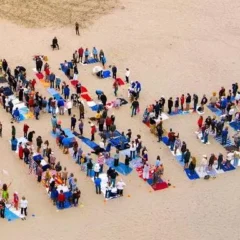A couple weeks before the picture went viral, I stood on the very shores where three-year-old Aylan Kurdi’s body was found. I was in Turkey for a wedding and spent four days in the beach town of Bodrum. We took a boat ride in the very waters that took little Aylan’s life. Bodrum was beautiful, bustling, fun; Europeans, Americans, Russians, Arabs and Turks enjoyed the nightlife, roamed the souks, danced, shopped and just enjoyed the summer breeze.
But, beneath it all, hints of the instability in neighboring Syria were palpable. Everywhere I went, I met other Syrians. They were shopkeepers, waiters, street vendors and beggars. I met Kurds, Syrian Christians and Muslims. Every day, Syrian women, their children in hand, would roam the streets and mosques, begging for money. Almost everybody I spoke to had lost a loved one. Their presence was a nudging reminder that the beautiful beaches we were standing on had become much more than a summer destination—they were a safe haven for people escaping a brutal war next door, a safe haven for my people.
Pictures of refugees making their way to Europe—and of little Aylan, in his red shirt, his shoes still on—helped awaken the world’s consciousness. For a few weeks, I received emails or calls from friends asking what can be done. I pointed people to cash strapped humanitarian agencies, to individual initiatives, to medical organizations helping the injured inside Syria.
And, for the first time in years, I thought maybe something would finally be done to stop the bloodshed. As I watched the little children beg with their mothers in Turkey, I couldn’t help but think of those, especially the children, still living in Syria.
My aunt, a widow, has chosen to stay in Damascus, Syria with her three children and three grandchildren. I used to visit her weekly when I lived there nearly a decade ago, covering Syria for western newspapers. We went to dinners, took weekend trips to the near-by mountains, visited friends and family.
The Syria she now describes is unrecognizable to me. Even though Damascus is safer than other parts of the country, the Syria of coffee shops, nightly dinners and weekend visits to farms no longer exists. Early on my aunt’s family business was looted by thugs. Her youngest daughter took a secretarial job and has become the family’s sole breadwinner. They have witnessed gun battles; slept in hallways to avoid bullets and shrapnel; felt their building rattle from near-by explosions. These days, they go to bed listening to explosions from neighboring suburbs – the sounds of war are unrelenting.
A few weeks before Aylan’s picture went viral, I spoke to her by phone. She told me things had become more difficult. I asked her if she was finally thinking of leaving. She won’t leave without every single member of her family—many people who leave must leave someone behind, sometimes for logistical reasons. The elderly often are unable to make the difficult journey; sometimes a daughter or son must stay behind, sometimes even a child.
My aunt has always feared being a financial and physical burden on others – something that many refugees worry about. Living in a strange country without an income, or feeling like she might become a burden on her siblings in the U.S. – despite their objections—makes her stay put.
I asked her about her grandchildren, who are my children’s age, 3 and 6. She was quiet, seemingly pensive. Then, she said, “You know, they say funny things now, it breaks your heart. It really breaks your heart. When they don’t like something, they say, ‘teta, (grandma) I’m going to blow you up.”
I was silent. I could hear her tears.
Samer, the 6 year old, has started drawing pictures of guns. He would extend the barrel of the gun and turn to her, saying, I’ve made it into a rifle. And, then he’d transform that same drawing into a missile or a tank. These kids are not inherently prone to radicalism. They are no different than my children or yours. But, at too young an age, they have come to know the sounds, the smells, the stories of war.
And, most of all, they are fearful. Samer refuses to sleep on their couch in the living room, convinced that missiles can reach their living room. He thinks his bedroom is safer.
If my father had not chosen to leave Syria more than 40 years ago, it would be my daughter or son drawing these pictures. I started to cry as well, horrified that this little boy, at such a young age, has experienced so much fear. Many children have witnessed so much more.
A new generation of Syrian children—both inside and outside of the country—cannot envision a proper future for themselves. A Human Rights Watch report released this week found that fewer than one-third of the 700,000 Syrian school-aged children in Turkey are attending school. Although the children in refugee camps are in school, nearly 90 percent of the children living outside of refugee camps are not.
“What can we do?” my aunt asked, as we said our goodbyes. “What can we do?”
The truth is, for too long, the world has done too little. The U.N. and aid agencies have been warning the world of its inability to deal with the overwhelming needs of the crisis. For years, leaders have said that the Syrian conflict is not our problem. President Barack Obama called it “someone else’s civil war.”
The hopelessness felt by so many is not completely unfounded. Over time, a well-intentioned revolution has turned into something so much bigger and uglier– both a regional proxy war between Saudi Arabia, its allies and Iran; and an international one between the U.S. and Russia. The Shiite-Sunni “hatred” that had once been virtually non-existent have been inflamed. Surrounding countries have sent and financed foreign fighters, and the rise of extremist terror organizations, like ISIS and al-Nusra Front, have flourished in the power vacuum.
But we cannot just step aside and let Russia fill that power vacuum with its bombing campaigns that have target rebels fighting the Syrian regime. Allowing the pre-war conditions to return Syria will not be an answer to a war that has left more than 250,000 dead.
When I think of Syrian children, I remember a phrase that a wise Muslim-American leader in Los Angeles used to say. Hassan Hathout grew up in the Arab world and, as a former political prisoner in Egypt’s prisons, he keenly understood the value of freedom. He used to say that real Islam will rise in the West. Not because he believed that Islam would take over. But he believed that for real Islam to flourish, it required freedom.
Last week, Farid Zakaria quoted Rachid Ghannouchi, the leader of Ennahda, Tunisia’s Islamist party. “The most important contest in the world right now is between the ISIS model and the Tunisian model. It’s not between Islam and the West,” Ghannouchi said. “The only way to truly defeat ISIS is to offer a better product to the millions of young Muslims in the world. We do: Muslim democracy.”
Many pundits have concluded that the failed revolutions, the failure of the Muslim Brotherhood and the rise of ISIS mean that Islam has shown its true incompatibility with democracy and with “Western values.” But these refugees, whether Muslims or Christians or Kurds or Druze, want freedom, the freedom to practice their own faith, to be safe in their homes, to be free of ISIS or Assad-like tyrants, freedom to speak their mind.
These refugees traveled to Europe, not Saudi Arabia, to build a new life, to seek refuge from the violence and the war. They don’t want to go to a country where women cannot drive and will be forced to cover their hair and dissidents face the death penalty. Only in free societies can Islam function as it should—as a religion that rejects compulsion, as a religion that respects the rule of law, as a religion that promotes pluralism.
We all have to worry about radicalization. There is no fence or wall that can or should divide the “Christian” and “Muslim” world. Closing our hearts and our borders will not bring safety. What will happen to my cousin’s son is our problem. And we have no choice but to be a part of the solution.
Photo Credit: IHH Humanitarian Relief Foundation / Flickr
Rhonda Roumani is a contributing fellow with the USC Center for Religion and Civic Culture and a journalist fellow with the Spiritual Exemplars Project.






